#The World of Greyhawk
Text

Ad in Dragon 37, May 1980, for The World of Greyhawk, the original 1-volume folio version with map by Dᴀʀʟᴇɴᴇ, TSR, 1980 (edit: with David Sutherland cover art)
#D&D#Dungeons & Dragons#David Sutherland#The World of Greyhawk#Greyhawk#dnd#AD&D#Gary Gygax#fantasy map#Darlene#Dᴀʀʟᴇɴᴇ#Darlene Pekul#heraldry#Dungeons and Dragons#1980s#TSR
81 notes
·
View notes
Text

Darlene's map (two 33" x 22" posters) for the 1980 World of Greyhawk fantasy setting. Still a beautiful work, in 1980 a hex overlaid, poster-sized, two-part RPG setting map with hand-scripted labels and full color was remarkably advanced for its time. The map is still held in high regard today, along with the artist. The map itself shows only the Flanaess region, as the scope of the entire continent (and the fantasy world of Oerth with more continents) was too large even for this size… a historic entry on Map Monday aka Dungeon Day!!
#map monday#dungeon day#greyhawk#world of greyhawk#flanaess#map#maps#cartography#fantasy maps#d&d#dungeons & dragons#dnd#rpg#ttrpg
13 notes
·
View notes
Text
Leading the way in terms of awards was the much-anticipated Baldur's Gate, a fantasy role-playing game set in the world of Dungeons and Dragons.
-TLDR News Daily

#dungeons and dragons#dnd#D&D#dnd memes#baldur's gate#forgotten realms#eberron#dark sun#kingdoms of kalamar#dragonlance#ravenloft#ghostwalk#warlords of the accordlands#midnight rpg#weird war 2 blood on the rhein#swashbuckling adventures#oriental adventures#rokugan#al qadim#planescape#spelljammer#gamma world#mythic vistas#birthright#greyhawk#1985 Dungeons and Dragons cartoon#7th Sea#Mystara#legend of the 5 rings#scarred lands
4 notes
·
View notes
Text
#tsr#dnd#dungeons and dragons#kara tur#kara-tur#karatur#forgotten realms#ttrpg#rpg#toril#faerun#mobs#monsters#monster#dragonlance#dark sun#al-qadim#greyhawk#hollow world#known world#mystara#planescape#ravenloft#spelljammer
2 notes
·
View notes
Text

Hmmm… I might have overdone it over the years with collecting D&D… what do you think?
#dungeons and dragons#dungeons dragons#dnd#rpg#fantasy#high fantasy#sword and sorcery#D&D books#dragon magazine#dungeon magazine#Dragonlance Modules#Forgotten Realms Modules#world of greyhawk
4 notes
·
View notes
Text
The problem with me making an earnest attempt to learn anything about FR is that it inevitably reminds me of how much I like Greyhawk and how good the Greyhawk community resources online can be and how Greyhawk has such a lovely and well developed wiki that is not on Fandom and I could be reading fun myths about hanging the corpse of the god of nature from a tree every winter or something instead of whatever the fuck else I was doing
#greyhawk. I miss her.#carmen's original campaign world...#had a paizo sighting on great library of greyhawk earlier. hey guys#I should sleep I'm going to sleep now but I want to dig up a bunch of splats and dragon articles instead :sob:#rambling
1 note
·
View note
Text


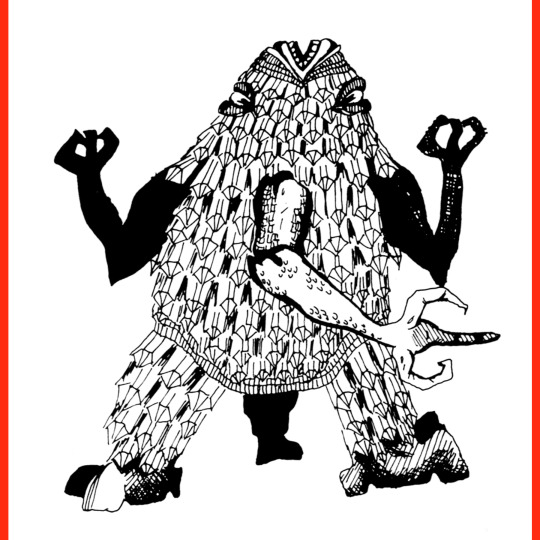


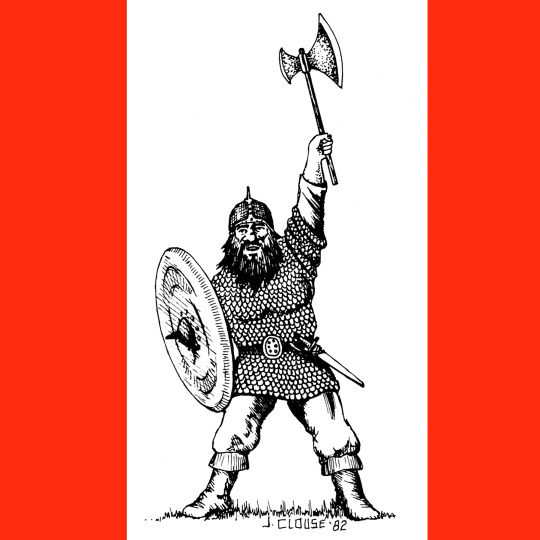
This is Dwarves (1982), the first of Mayfair’s Role Aids sourcebooks for D&D. It’s a little low rent but it is actually an example of outsiders understanding what early D&D players wanted better than the folks making D&D. The cover says this is an adventure, and there is one, and a bunch of adventure locations, but this is primarily a book of lore.
It’s pretty clear in the table of contents: “Chronology,” “Life in Ostohar,” “Religion,” “The Dwarven Rite” and so on — the book covers the history of dwarves, where they live and how they live in rich detail. We get gods, heroes, an explanation for their enmity with elves. Whereas in D&D at this point the only official knowledge about dwarves was their entry in the Players Handbook, and their entry in the Monster Manual. Noting that lack, the folks at Mayfair decided to fill in all the details they could.
This wasn’t unprecedented at the time. Cults of Prax came out in 1979, detailing the religions of RuneQuest’s various societies, and the Iron Crown’s Middle-earth books flesh out all aspects of the regions they presented. D&D had the World of Greyhawk map folio (1980) that gestures at this sort of worldbuilding without committing. More serious setting material from TSR would appear in the World of Greyhawk box set (1983) and in DL5, which is a sort-of sourcebook for the world of Dragonlance. Neither of these feel quite right in the way that Dwarves does for anyone who has ever read a ’90s era Forgotten Realms sourcebook. Dwarves and the other similar Role Aids sourcebooks nail the recipe that would dominate TSR’s approach to campaign settings and supplemental material from about 1986 until the death of the company. It’s weird!
Doubly so because Dwarves…isn’t really exciting. It’s a pretty conservative approach to dwarves the sticks to the genre clichés. You can only break so much ground at one time, I guess.
105 notes
·
View notes
Text
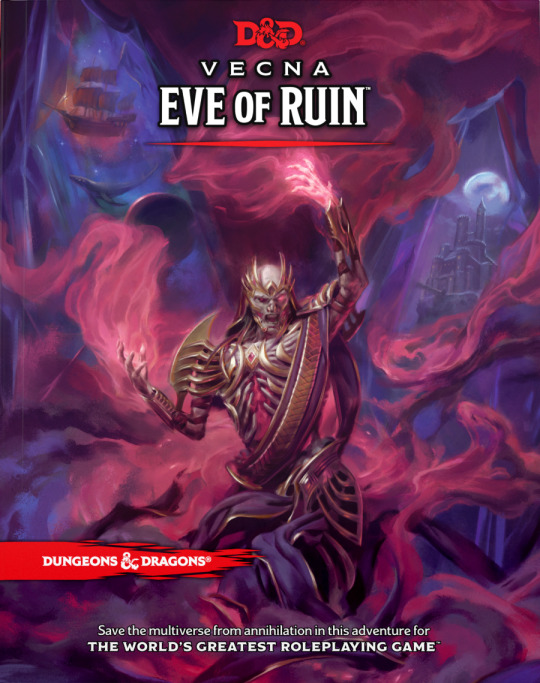
Vecna: Eve of Ruin
WHO WILL SAVE EXISTENCE?
Save existence from annihilation in this epic, multiverse-spanning adventure.
The notorious lich Vecna is weaving a ritual to eliminate good, obliterate the gods, and subjugate all worlds. To stop Vecna before he remakes the universe, the heroes work with three of the multiverse’s most famous archmages, travel to far-flung locales, and rebuild the legendary Rod of Seven Parts.
Vecna: Eve of Ruin is a high-stakes DUNGEONS & DRAGONS adventure in which the fate of the multiverse hangs in the balance. The heroes begin in the Forgotten Realms® and travel to Planescape, Spelljammer, Eberron, Ravenloft, Dragonlance, and Greyhawk as they race to save existence from obliteration.
A DUNGEONS & DRAGONS adventure for characters of levels 10–20.
GET AN EXCLUSIVE BONUS ADVENTURE
Prepare for the final battle with Vecna: Nest of the Eldritch Eye, a single-session adventure that foreshadows the events in Vecna: Eve of Ruin. This D&D Beyond exclusive releases 4/16 and is available with digital preorder only.
Vecna: Eve of Ruin, a 256-page hardcover adventure book for 10th to 20th level characters
Double-sided poster map
30+ Terrifying new monsters spawning from all over the multiverse
Detailed character dossiers with exclusive insights into legendary allies who you may recognize from other D&D adventures
D&D Beyond digital copy of Vecna: Eve of Ruin
PREORDER TO UNLOCK:
D&D Beyond access to Vecna: Nest of the Eldritch Eye, starting April 16, 2024
Early access to Vecna: Eve of Ruin on D&D Beyond, starting May 7, 2024
Hardcover – 21 May 2024, from Wizards of the Coast.
31 notes
·
View notes
Text
i couldn't see (you were always right beside me) | 13.5k
Three hours later Steve logged off to get ready for his shift at the hospital. He was several levels higher and had finished the quests in Darkshore with the help of Greyhawk. He also had a friend listed in his friends list.
Greyhawk had said that being friends would let them be able to tell when the other was online so they could quest again. Steve really liked the sound of that. He didn’t have many friends his own age. He and Robin basically lived in each other’s pockets at work, but with Robin’s new girlfriend and their sleep schedules, they didn’t end up getting to hang out more than once a week.
A new friend sounded really nice, especially given that it was unlikely he would ever get along with his neighbors. The only resident Steve’s age on this floor was the neighbor he hated and that was very unlikely to change anytime soon.
OR
Steve hated his neighbor. And then Dustin and the other kiddos left for college and Steve signed up for some online game called World of Warcraft. Which was how Steve met a Night Elf druid named Greyhawk.
#steddie#steddie fic#stranger things#stranger things fic#steve harrington#eddie munson#steddie modern au#more or less. i played fast and loose with the timeline#ori writes
183 notes
·
View notes
Text
If there's one thing I'd have to name that kept 4th Edition D&D from reaching its full potential, it's that the Monster Manuals didn't have enough critters from Mystara.
See, before your Eberrons, your Forgotten Realmses, your Dragonslance, and only a bit after the release of the World of Greyhawk Folio, there was a land undreamed of, known then only as the Known World, and later as Mystara. This was the setting of the B/X, BECMI, and Rules Cyclopedia versions of D&D, and oh boy was it bonkers.
The Known World was what settings like Forgotten Realms are accused of being, a mish-mash of lands inspired by disparate real world cultures, with the Scandinavia-inspired Northern Reaches right next to the Arabia-inspired Emirates of Yularuam. There was a whole Hollow Earth thing going on, and ancient scientific civilizations! It's great!
In many ways it lived separate from the other settings, being made for a different version of it for one thing, but also in its selection of monsters. While Dragonlance may have had some restrictions like no orcs, after the Basic and Expert sets the selection of monsters really went in its own direction for the Known World. And it had a bunch of monster books with all sorts of weird creatures not seen in other settings. It didn't converge with the AD&D line until a few sourcebooks were released for 2nd Edition under the name Mystara.
So what does any of this have to do with 4th Edition? I consider 4e, in its structure, the closest inheritor of BECMI. It's split into easily distinguished level tiers (Heroic, Paragon, Epic), it very nearly has the classic three-alignment system of old, and it has a built-in way for player characters to become deities.
So it would be really nice to run a Known World, or Mystara, campaign with 4e rules! But alas, many of the unique critters of the setting have not been seen again, with only some sparse appearences in 3rd Edition.
Sure I've got the classics like goblins and centaurs and hydras, but where are my hutaakans and lupins? Where my fyrsnaca at? And how am I supposed to do this without the trusty sacrol?
"You should homebrew them!" And you should call your dad more often. Say hi from me, and tell him I had a lovely time last night.
24 notes
·
View notes
Note
What do you think is the most underrated campaign setting?
There are so many published settings and all have their advocates, so I can't think of an old setting that hasn't been hyped by someone. The Bronze Age world of Glorantha wasn't originally appreciated by many Runequest players or 3rd-party publishers who were used to medieval fantasy, but it is well-loved now.
It's certainly not an obscure indie product, but I really want to say the original Greyhawk is underrated compared to the Greyhawk that people encounter when they try to research it now on the web. I see people say Greyhawk is massive and intimidating and they don't know where to start with it, and they are exactly right if they are looking at all the wikis and websites and finding it seems to be a bloated mess.
The games I run in Greyhawk are based on the 2-volume boxed set from 1983, expanded from Gygax's original 1980 folio version. It is a vast world but described in thin outlines, and focusing on just one region allows a DM to start playing with very little research then add detail slowly over time.
The map is a mostly empty world of wilderness dotted with outposts of civilization, so a DM can fill that space with anything planned or ad-libbed, with no need to worry about contradicting "canon" that hadn't been written yet in 1980/83. I can pick and choose whether to include something from a later publication or rework it thoroughly to suit my purposes.
That should be true for any DM running any campaign setting, but a lot of Greyhawk fans seem to think they absolutely must adhere to everything ever written. At my table there have been no Greyhawk Wars and probably never will be. Nothing from Living Greyhawk is canon to me, though I'll borrow some bits of ideas here and there. Entire cities and factions invented for streamed campaigns that have wormed their way into the wikis don't necessarily exist in my game either. But I have heavily modified some late 3.5e content from Paizo's Dungeon magazine because it contained good plot hooks.
59 notes
·
View notes
Text
144. Various Authors - Dragon #55 (November 1981)

As we approach the end of 1981 we get the November issue of Dragon with a cool Erol Otus cover. The issue marks the return of an important part of the magazine and TSR in general, by bringing back Gygax's From the Sorcerer's Scroll column, which had been absent for over a year at this point. Gygax writes about the world of Greyhawk and again return to the issue of "race" in Greyhawk, a lot of talk about "pure" and "mixed" races which feels not only uncomfortable but unnecessary, also because he had already written this in #52 as an addendum to Lakofka's Tiny Hut. At least he promises to being new content in the next issues. But it's not all about returns, there is also someone new showing up here and that is Larry Elmore that contributes a new comic strip at the end of the magazine, but more importantly will be one of the most important (together with Clyde Caldwell) artists that will set the visual identity of AD&D for the rest of the 80s and beyond.

However, the magazine starts off with a couple of reviews of the Fiend Folio by Ed Greenwood (who gives it a pretty negative review) and Alan Zumwalt (who gives it a middling one) as well as a reply by editor Don Turnbull. Turnbull explains, and he is right, that many of the problems pointed out are a result of a really difficult publishing history which made the book exist in a limbo for about 2 years before publication, making it outdated by the time it came out.
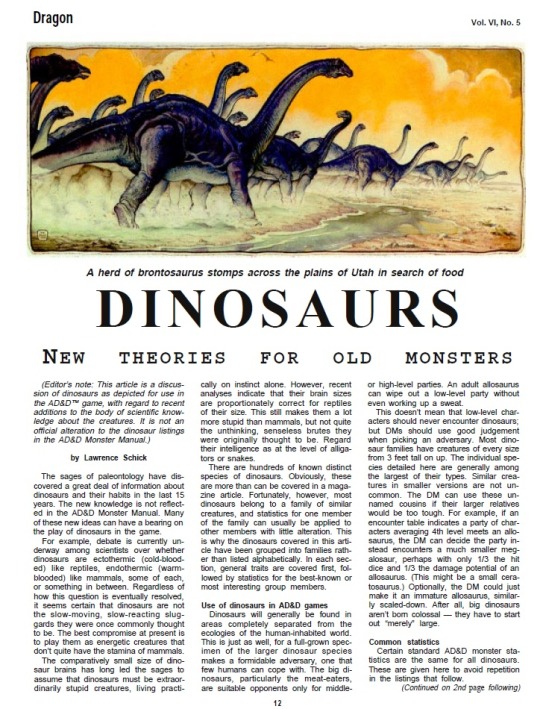
We also get new stats for Dinos in AD&D, stats for Robin Hood and his Merry Men, a little adventure module and an article on how your characters can run away from danger in dungeons. We also get the usual bestiary and comic strips with the addition of Da Letter by Larry Elmore.
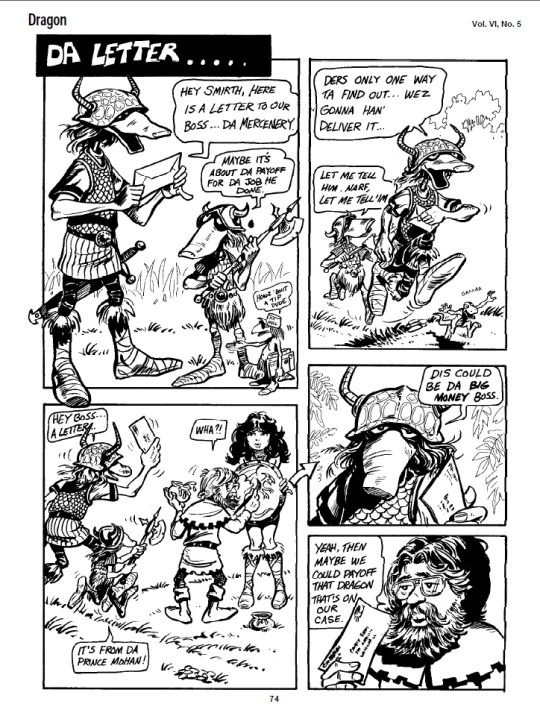
48 notes
·
View notes
Note
My character learned to fight with staves and spears, what would it be better for her to take to a “DnD style” dungeon? (The world is similar to DnD world, although the spear is seriously underpowered in the rules)
So, I'm going to start with a couple nitpicks.
As someone with tabletop RPG experience, labeling it as, “D&D world,” is a really weird thing to read. D&D is primarily three distinct things. The rule systems themselves, and at this point we're up to the sixth or seventh major rules iteration. D&D as settings, except you'll almost never hear this one phrased that way. Finally, D&D as branding, which is extraordinarily nebulous, and tends to pick iconography out of the rules or settings. Simply identifying something as D&D could refer to any of these.
Officially, D&D has roughly 20 campaign settings. Any one of those could be categorized broadly as, “a D&D world.” Depending on the edition, the default setting is either Greyhawk or Forgotten Realms. These are entirely different worlds. Greyhawk is more of the conventional medieval fantasy world, while Forgotten Realms is a setting with mountains (in some cases, literally) of fallen empires, and the world is filled with ancient ruins, in addition to the current civilizations. Both of these are extremely detailed settings with thousands of pages of background lore.
Beyond that, Dragonlance, Dark Sun, Ravenloft, Planescape, Ravnica, Eberron, Spelljammer, and Urban Arcana, all come to mind as official TSR/Wizards of the Coast settings. And it's extremely likely that even players with an extensive familiarity with the ruleset missed at least one of the above names. This isn't even counting a lot of minor settings, or the fact that Planescape and Spelljammer are both multi-world settings, and the fact that a lot of these settings technically cross over. There are Spelljammer ports on Faerun (the main continent of Forgotten Realms), and races native to Planescape (in particular the Tieflings) have become a mainstay of the games, as they wander across the planes, to the point that Planescape's Tieflings and Aasimar exist in Pathfinder.
So, “The D&D world,” doesn't really say much.
With a lot of tabletop RPGs, the setting is analogous to the ruleset. When you're talking about running a Shadowrun campaign, or a Vampire: The Masquerade chronicle, those are specific worlds. The biggest ambiguity is which edition. However, when you say you're participating in a D&D campaign, that doesn't tell you much on its own.
If you're asking from a rules perspective, that's going to depend on the edition, and this is where stuff gets a little complicated.
If you're working with the idea of a D&D style dungeon, it's probably best to consider what era of game design you're looking at. There are a couple ways you can approach dungeons.
So, basic thoughts on dungeons.
Small dungeons are designed to be finished in a single session or two. You're probably looking at a few combat encounters. But, the main arc is that your characters travel to a dungeon, they do whatever they were planning to, and get out. You might have as many as four rooms, but generally these are pretty compact spaces.
Large dungeons can either be designed around the adventurers spending multiple days in the dungeon itself, or they may be traveling in and out and resting somewhere outside. (In some cases, you'll even have towns or inns set up over the dungeon. So your adventurers are all in one compact space.)
Additionally, large dungeons can be designed around the idea that the players will penetrate a few levels at a time, gradually working their way deeper over time (as they deal with other events and problems), or it can be a very long excursions, with adventures scavenging and hunting in the dungeon for days or weeks as they progress.
In the case of truly monstrous dungeons, they might even be bringing enough personnel and resources to set up various base camps and have a full supply lines running back to the outside world, as they gradually expand their control over the dungeon.
Sort of in parallel to this, it's worth thinking about what the dungeon is. The basic concept is often, as the name implies, some kind of semi-ruined castle prison. But, you'll also frequently see crypts, and caves as dungeons. Especially as small ones. At the same time, it's worth considering expanding your concept of a dungeon a bit. Ancient ruins, old fortresses, necropolises, abandoned mines, and sewers are common. (Sewers are a little unrealistic, as real ones don't tend to be massive underground pipes you can walk in.) What's less common are massive shipwrecks, overrun cities, entire islands with dangerous flora and fauna (or just pirates), fallen cities (where entire city districts collapsed during an earthquake and now exist below ground), plague ridden city districts (plagues can actually be a lot of fun, because it will let you transform familiar territories into hostile ones as the campaign progresses. Pathologic does this extraordinarily well.) In a rather famous D&D adventure (Expedition to the Barrier Peaks), one of the dungeons is a downed spacecraft. This is before we consider dungeons with impossible geometry, such as ones that leak over into another dimension (possibly as a result of magical experiments gone wrong, or ones that exist in the dreams or psyche of an individual. (For the record, I'm not a huge fan of psychic dungeons as a play experience, but they can be done well. I've simply had some bad experiences with the concept.) Shadowrun had a related concept, with cyberspace (called, “the matrix”), as a parallel space where hackers would engage in combat parallel to the events happening out in the real world. It's weird concept, but one that you might get some millage out of, and having a parallel battle on the astral plane wouldn't be that weird for D&D.
Moving beyond that, there are some semi-common dungeon settings that you don't often see in D&D, for obvious reasons, but might fit if your setting accommodates them. Abandoned research labs, abandoned industrial areas, abandoned villages or suburban areas at the edge of a city. Bonus points if the reason it's abandoned is related to why your players are wandering into it now. City districts under lockdown, usually this will either cater to a stealth focus, and might work if you have a group of thieves or something similar, (though, at that point, Blades in the Darkmight be a better RPG pick), this setting also works when the group enforcing the lockdown are acceptable targets, such as gangs or cultists, and for bonus points you can organize these setups with multiple factions and your characters may even be able to play groups against one another, all of this also works for feral cities (which also work as large area dungeons.)
With any dungeon, you probably want to consider how it fit into the world before it became a dungeon, and how long it existed as a dungeon before your players wandered in and started ripping the place apart.
So, ultimately, the question is about the spear and staff in the rules, as you're probably looking to approximate the rules to some extent. The problem is the rules have changed a bit over the years. One problem is that the default spear is not a reach weapon, meaning you can't use it to hit targets more than a space away from you. D&D splits that into the longspear, which is a reach weapon, and you can hit targets two spaces away from you, though you do need to use a 5ft step to back away from someone in an adjacent space before you can attack them. Both spears and staves are simple proficiency weapons though some editions do let you use the staff as a double weapon (meaning you can effectively treat it as dual wielding, if you have the feats.) If you do have a second attack with the staff, or you expect to be dealing with enemies that resist non-blunt damage (like skeletons) the staff starts to become a lot more attractive.
If you're using a different ruleset from standard D&D, there may be other considerations. I'm thinking of Total War's Anti-Large rules in particular, which do make spears very attractive against larger foes as they'll deal additional damage, similarly if you have some kind of homebrew piercing damage bonus against armor, that could make the spear conditionally more appealing. And, if your character is expecting to face down minotaurs or giants, then a longspear would be a much better choice with those modified rules. Though, this comes with another consideration, back in 3.5e the longspear was a simple proficiency weapon (just like the staff and spear), but was upgraded to martial proficiency in 4e, and seems to be missing in 5e (or it was replaced with the pike, which is also a martial weapon.) The longspear (and pike) do have special rules which allow them to be braced against a charging foe dealing increased damage. So, that might be worth considering for your choices. But, again, unless you're getting proficiency for the entire spear family, this might not be a practical option.
Usually, when you're arming characters for D&D, the primary consideration is going to be the overall thematic style of the character. Sometimes you do need to go out of your way to ensure a character gets the relevant proficiency (such as a rapier wielding wizard), but generally speaking, that theme is going to inform whether a character gets a spear or staff. If you've got a druid, then the spear might make more sense. If you have a wizard or sorcerer then maybe the staff is preferable (particularly if you can use it as an arcane focus.) (Though, wizards and sorcerers don't get spear proficiency in 5e, so, that's a factor.)
That said, you're not wrong, D&D has not done a good job with the spear. Part of that is because the default D&D spear is remarkably short. In 5e, the weapons are mostly interchangeable aside from the damage type, but the staff has more potential utility (specifically the ability to get staves crafted as arcane focuses, and a wider range of enchantments for staves.) Both are 1d6 with 1d8 versatile (if wielded with 2h the damage die is increased.) This is in contrast to 3.5 where the staff was 1d6, but was a double weapon, while the spear was 1d8, had the ready against charging characters action baked into the item (without the reach keyword), and had an increased crit multiplier (x3, meaning the weapon did triple damage on a crit, though it shared this with most axes), but it was a two-handed weapon.
I suppose if your character is a spellcaster, the staff is a better choice, as it gives you more options. But, when you're talking about someone who spends a lot of time out in the wilds, a spear might be a better thematic choice. If you're working within some version of 3rdedition, then the spear does look more valuable, but in 5e it is an underwhelming choice.
-Starke
This blog is supported through Patreon. Patrons get access to new posts three days early, and direct access to us through Discord. If you’re already a Patron, thank you. If you’d like to support us, please consider becoming a Patron.
49 notes
·
View notes
Text
#huh my circles of people have merged again#what the FUCK is going on with the Drow lore#like#W H Y is it the way that it is#Everything about their lore feels like it's a dark glimpse into a world of weirder and weirder kink via @thepioden
Moving this here so I'm not unnecessarily clogging OP's post but I'm pretty sure drow lore is Like That because for a good while a lot of the sourcebooks absolutely refused to talk to the drizzt novels, some authors just straight up drew from greyhawk/the old old modules where it was BARK BARK HORNY LEWD DROW DOMINATRIXES BARK BARK because gary gygax was unfathomably horny, and the guy writing the novels was literally told nothing as a work for hire but also is the opposite of unfathomably horny so.
Basically there's like two or three different streams of lore (though most of the worst stuff is gone now, thank god) and people fight about it all the time because some people conflate everything together and a lot of people blame the novels for things they demonstratably did not do, because it's easier to read a sourcebook than a novel presumably.
And yet, it's still not as much of a mess as surface elf lore, which was a collaborative project in making them absolute xenophobic nightmares for no apparent reason, accidentally
32 notes
·
View notes
Text
I have no idea if this will be a two part post or a series of things, but I wanted to write a little about Forgotten Realms for new BG3 fans. I decided the best start was here:
Baldur's Gate Primer: Fantasy Kitchen Sink and CRPGs
The Forgotten Realms began as an official campaign setting for Advanced Dungeons and Dragons ("1e") in 1987 and published by TSR Inc, the gaming company that originally published D&D.
Since its introduction, the Forgotten Realms' world of Toril has been wildly popular, jumping over the then more established Greyhawk, Dragonlance, and several other settings whose influences were based High Middle Ages Northern and Central Europe (and the unfortunate implications of Central Asian Nomads with monsters such as orcs and goblins). Ed Greenwood is the loving (if slightly horny) creator of the Realms, though many authors have written stories within the setting for several good reasons.
The Realms is an excellent Fantasy Kitchen Sink.
While Toril has several European influences, it has little to do with High Middle Ages in world building and more to do with 19th century based on nation states with the aesthetics of the Late Renaissance in terms of art, culture, and technology.
Toril also took inspiration from other cultures with their nations and continents:
The first of Toril's continents written about was Kara-Tur, which was introduced before the 'official campaign book' and heavily focused based on East Asian.
Another continent based on Central Indigenous nations (Mayan and Aztec) called Maztica, who are giving the Faerun colonists hell due to their magic and their immune systems, and consider themselves the 'True World'.
There’s the nation of Zakhara that’s based between Faerun and Kara-Tur, making it a touch on the nose since it's based on Arabian Nights.
The nation Chult is based after the Congo Basin rainforest, though it really seems like whoever made this development slept through Heart of Darkness. (It went away for a little while, but it's back now.)
Meanwhile Calimshan and Mulhorand are based after Morocco and Egypt.
Bear in mind, despite good intentions that Ed Greenwood and TSR had, a lot of the old lore comes off as Orientalist, and WotC hasn't done much to update it save slapping a disclaimer on PDF files and not much else with these settings save a bare description.
However, if some dork-ass tells you that Wyll and BIPOC are going against the lore accuracy, tell them to fuck off. The Forgotten Realm was introduced with a BIPOC setting despite it’s flaws.
Due to the diversity of the 'Realms', the setting has attracted writers, artists, and campaign designers who developed some of D&D's most iconic characters and thus influenced a lot of how D&D's multiverse structure. Players loved the lore of the Realms and the feeling their characters could be from anywhere and do anything. This is in contrast to Greyhawk never really growing past it's War Game boundaries as a world and Dragonlance's creators being highly protective of it's inflexible plot with the lack of multiple settings.
So it made sense when TSR approached the game developer SISI with their Gold Box Engine with the Forgotten Realms in mind. SISI's first D&D based game is called Pool of Radiance, and the game took place in Faerun’s Moonsea region in the ruins of Phlan, where adventurers fought off undead and fiends to help give a new city a fighting chance in rebuilding. While SISI would dabble in Dragonlance and Dark Sun (a post apocalyptic setting that is so fucking grim dark, Githyanki ran away from Dark Sun's world of Athas screaming), most of their games were based in Forgotten Realms.
For those curious about the Gold Box Game series: when BG1 was my 13 year-old-heart's special interest, I played them. It's really, really weird because so much of the story is in the manual and clunky as fuck. But I was itching to play anything DnD at the time.
In 1997, TSR was purchased in 1997 by Wizards of the Coast (WotC), though it allowed the continued development of yet another CRPG set in the Realms by a then unknown company called Bioware. In 1998, Bioware released Baldur's Gate and using the Infinity Engine Bioware, Black Isle, and WotC would continue to make several games including BG2, BG:TOB, and Neverwinter Nights before parting ways in 2006 with Bioware. Bioware would then focus on its own wildly successful CRPG IPs.
By then, WotC was owned by Habsro (since 1999) and after two decades of excellent turn based CRPGs, they stopped focus on the genre when Neverwinter Nights 2 didn’t do as well as its predecessor and focused on different genres such as Hack’n’Slash, Action Adventure, and Boardgames - though they were all set in the Forgotten Realms.
However one of these games would reach the popularity of the Gold Box, Infinity, or Aurora engine based games (BG, Icewind Dale, and Planescape Torment) . The only turned based CRPGs that were released from 2007 to 2020 were remakes of the Infinity Engine games by Beamdog Studios who attempted to get the rights to make BG3.
WotC declined Beamdog, deciding to approach Larian studios instead for Baldur’s Gate 3 in 2016, likely wanting to approach a style closer to Neverwinter Nights rather than isometric. Due to D&D new popularity, both companies expected that BG3 would do well, but neither company had any idea how big Baldur’s Gate 3 would be.
I'm likely going to do a post on the important historical events in the Realms mentioned in BG3 - and some that are not.
19 notes
·
View notes
Text
Disparate Thoughts on Dungeon Meshi
I'm an anime-only watcher, so no spoilers beyond what's currently aired (eps 1-3) + mild map spoilers for a random 3.5e D&D module (Sunless Citadel).
- I'm not the first nor will I be the last to harp on the English localised title but Delicious in Dungeon sucks. I do, however, think going with the "DnD" naming scheme was a nugget of a good idea (let's face it, "Dungeon Food" sucks too). Maybe "Diners in Dungeon"/"Dungeons & Diners" instead (as in those who dine, not a place where one dines). Or "Dungeon Dine" (like "dungeon dive"). Regardless, I'll just be calling it Dungeon Meshi going forward.
- I don't know if this is coloured by me going into this series with the knowledge that Ryoko Kui loves Baldur's Gate 1 and 2 or a wider ripple effect of eastern dungeon-fantasy conventions being shaped by there not being an official Japanese translation of D&D between Basic and 5e, but the world-building's vibe is old-school D&D as hell. It feels like it was written by someone who maybe never got the chance to play the tabletop game much but spent hours poring over the 1e Monster Manual in hopes of getting a campaign off the ground (and ended up penning a manga instead, game scheduling be damned). There's the disarming of traps, feeling for secret doors, and even the iconic red dragon as seen on the covers of the Basic Dungeon Master's Handbook and 1e Monster Manual being the dungeon boss.
Design-wise, the dungeon's layout it reminds me a bit of the map from Ruins of Castle Greyhawk or The Sunless Citadel (pictured below, right).
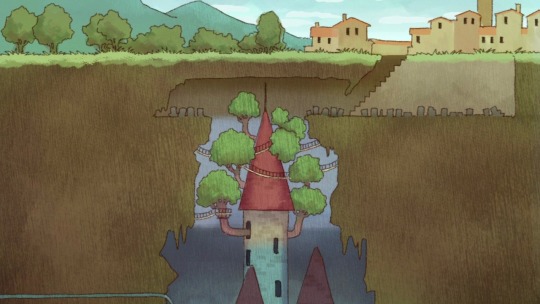

- The main cast is very tropey at the moment. Quite literally all the Basic classes are covered; the generic white man Fighter (Lv 1, no multi-attack yet :P) as the party face, the halfling/thief, the elf/wizard, the missing cleric, the dwarf... This works for this point in the narrative but doesn't make me particularly attached to any of them. They need another overarching obstacle.
- I generally don't like Studio Trigger's output (not the Imaishi-involved stuff anyway; Gridman fucks) but I respect how bouncy their animation usually is. So, I was excited to watch something animated by Trigger but not (originally) written by them. Dungeon Meshi, however, looks static and resorts too often to Dutch angles to maintain visual interest. There's a bit of an art shift in episode 3 where this improves; more fun "off-model" moments, the movements get a little bouncier, more color harmony. Hopefully, this stays and isn't just a guest director fluke.
Form the snippets I've seen on the manga, Kui suffers a bit from "draw background killed my grandma", thus her ability to make her simple character designs emote well has to carry the page. The anime does the opposite; super detailed backgrounds but flat shading/lack of texture on the characters creates a need for them to over-emote with a "screen-shake" effect in order to stand out from their surroundings, which I could see getting old fast.
The main event, the food, looks better in the anime than in the manga due to colour and animation bringing it to life.
- I don't usually laugh at Japanese comedies because they're either too slapstick for my tastes or too pun heavy for my JP comprehension level. Dungeon Meshi gets a point for making me "lol" more than once.
- Finally, a good panty shot:

- I watched episode 3 dubbed. EN Marcille > JP Marcille (I say this as a stickler for subs). The rest of the dub cast is fine but I'm probably sticking with JP because JP Laios' ability to scream > EN Laios (EN is a great generic white man, though). I'm not familiar with most of the JP voice cast. I think Chilchuck is my fave in JP.
Both languages have little breathing room between lines of dialog and I was hoping the EN dub would play around with the fact that the character speaking isn't necessarily the one on screen (thus less lip-flap matching, especially for Senshi, who has few indicators that he's actually speaking even when he's onscreen) but alas.
I'll do another one of these if I have more to say later in the season 🥂
10 notes
·
View notes